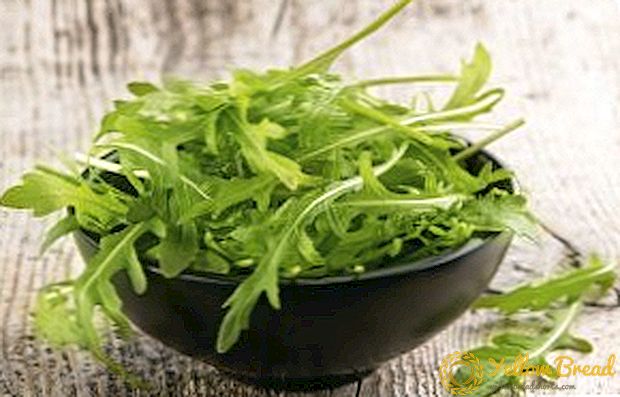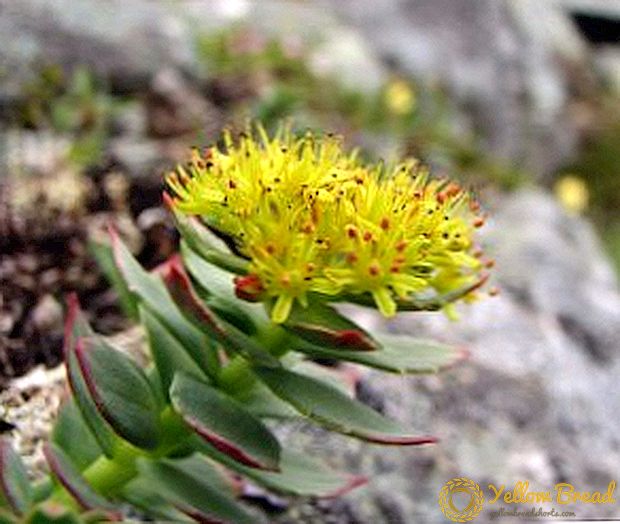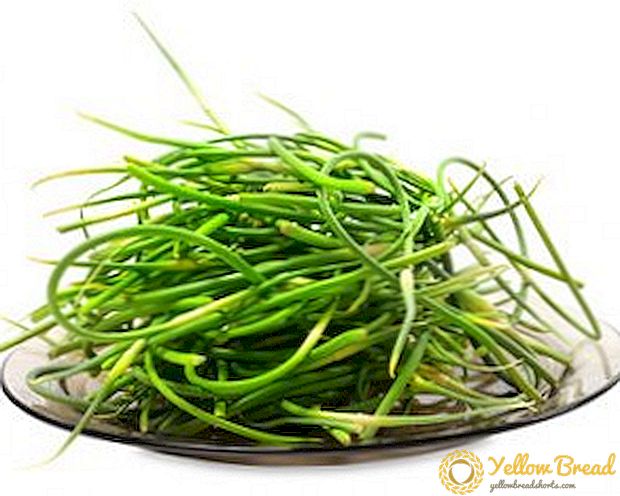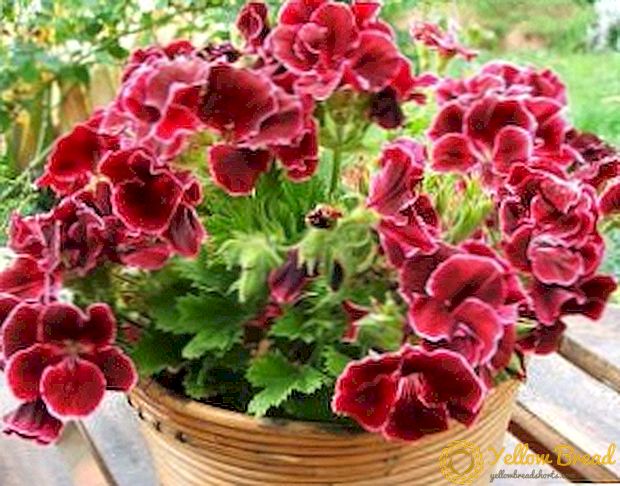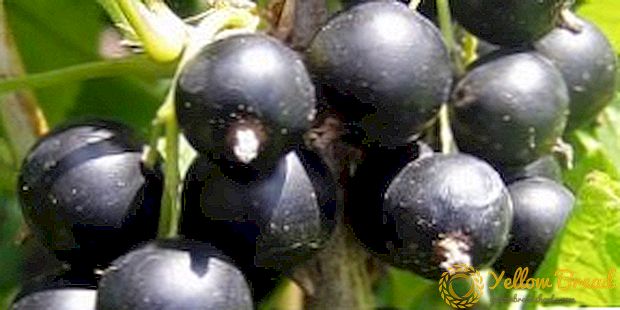 1995 was a turning point in the history of breeding. - He opened the era of growing gooseberries without thorns, varieties of which it was then that was the beginning.
1995 was a turning point in the history of breeding. - He opened the era of growing gooseberries without thorns, varieties of which it was then that was the beginning.
- The history of the selection of gooseberry varieties "Commodore"
- Characteristics of the gooseberry "Commander"
- The advantages and disadvantages of the variety
- Dates and choice of place for landing
- Preparatory work before landing
- Site preparation
- Seedlings preparation
- Proper planting of young gooseberry seedlings
- Care and cultivation of gooseberry "Commander"
- Watering and loosening the soil
- When and how to conduct dressing
- Trim highlights
- Shelter bushes for the winter
- Time of ripening and harvesting
The history of the selection of gooseberry varieties "Commodore"
The author of the first in the history of the bespodny gooseberry "Commander" was VS Ilyin - doctor of agricultural sciences, deputy director of the South Ural Research Institute for Horticulture and Potato and head of the laboratory at the same institute. It is curious that this outstanding achievement of breeding is only a wonderful episode of the scientist’s enormous labor contribution to the development of gardening - together with his wife, candidate of agricultural sciences, he is the author of eight dozen varieties of currant, honeysuckle, sea buckthorn and, of course, gooseberry.
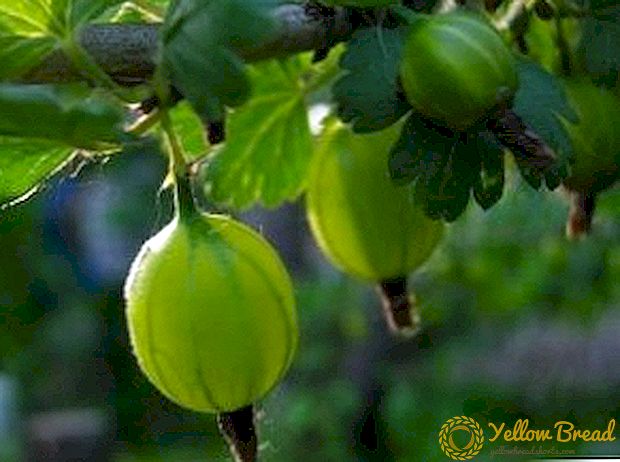 The medium-early variety of gooseberry "Commander" was the result of hard work in crossing the varieties "Chelyabinsk Green" and "African". Achievement is not only the absence of thorns, but also the preservation in the resulting variety of high yields.
The medium-early variety of gooseberry "Commander" was the result of hard work in crossing the varieties "Chelyabinsk Green" and "African". Achievement is not only the absence of thorns, but also the preservation in the resulting variety of high yields.
Characteristics of the gooseberry "Commander"
Flagship features - the bespodny gooseberry "Commander" is reflected in the now widely known description of this variety. In addition to the already noted lack of spikes and mid-early ripening, it indicates that:
- a dense medium-high bush has weak, but not very thick light green branches with a pinkish tinge below (on the sunny side);
- on the shoots grows brilliant strong foliage of large leaves with sharp, medium-sized teeth; at the base of the leaves there are small depressions (flat or rounded). The elongated oval buds have pointed tips;
- gooseberry blooms are collected in 2-3 inflorescences very beautiful bowls of yellow flowers with a noticeable greenish and slightly noticeable pink tinge;
- round red-brown berries are covered with a thin or medium thickness skin without pubescence;
- berries containing a small number of seeds gain weight up to 7 g (average weight - 5.5 g);
- sweet, with a slight sourish tint, moderately tart taste of the berries (4.6 points out of 5 on the tasting scale) is determined by the 13.1% sugar contained in them, as well as vitamin C (54 mg per 100 g) and three percent of titrated acidity.
The advantages and disadvantages of the variety
The undoubted advantages include:
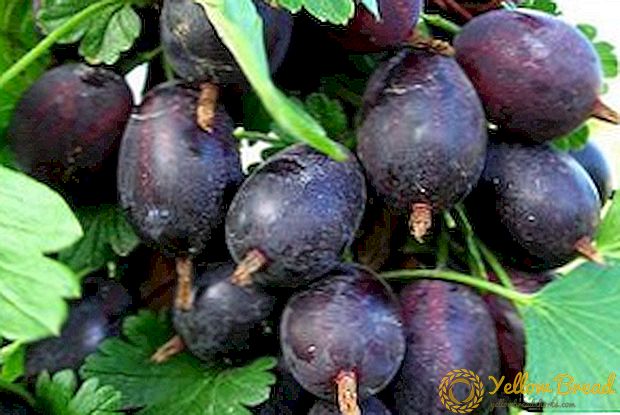
- long-term fruiting of the gooseberry "Commander", which forms the basis of its high yield - 6.8 (sometimes up to 7) kg per shrub;
- the strength of ripe berries, which, even at a very late harvest, do not crack and fall off the bush;
- winter hardiness of the gooseberry "Commander" and its good resistance to powdery mildew;
- the versatility of the use of the fruit "Commander".
Dates and choice of place for landing
The most suitable for planting seedlings of gooseberry "Commander" recognized sandy, loamy and sod-podzolic soils. This should take into account that stagnant water creates conditions for plant infection with powdery mildew and can lead to its death, and therefore the chosen area should not have a tendency to accumulate moisture.
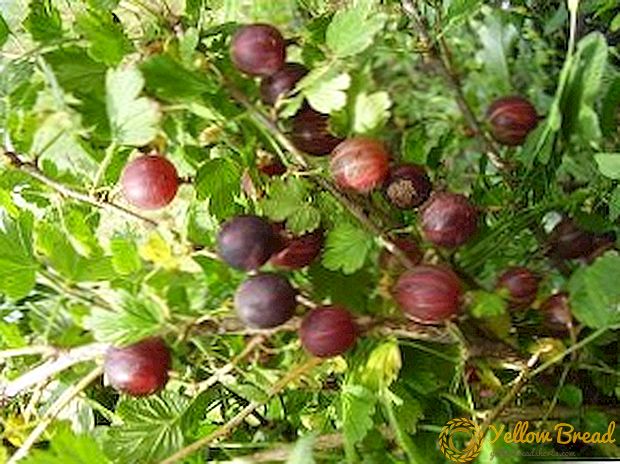 The young gooseberry "Commander" loves the warming rays of the sun, which he will receive in full if the site for his planting and subsequent care is protected (by natural or man-made barriers) from excessive gusts of wind. It is suitable for planting both the autumn (September-October) and spring (April-May) season. In the first case, the calculation is made on the best survival rate due to winter hardening, in the second - on the cultivation of a strong root system due to the rapid development in a comfortable temperature regime.
The young gooseberry "Commander" loves the warming rays of the sun, which he will receive in full if the site for his planting and subsequent care is protected (by natural or man-made barriers) from excessive gusts of wind. It is suitable for planting both the autumn (September-October) and spring (April-May) season. In the first case, the calculation is made on the best survival rate due to winter hardening, in the second - on the cultivation of a strong root system due to the rapid development in a comfortable temperature regime.
Preparatory work before landing
Planting gooseberry "Commander" requires not only care and thoroughness, but also preliminary preparation. The foundation for future success in the cultivation of gooseberries, the result of which will be a rich harvest, will be processing according to certain parameters of the selected land and planting material.
Site preparation
Before planting the gooseberry "Commander", as stipulated by the agrotechnics of its cultivation, a recess of at least 0.3 m is made in the ground with a diameter of the pit itself to 0.6 m, where fertilizer is necessarily placed. A mixture of 0.3 kg of powdered limestone, the same amount of wood ash (or 40 g of potassium salt) and several (up to 10) kilograms of straw manure is prepared independently.
Seedlings preparation
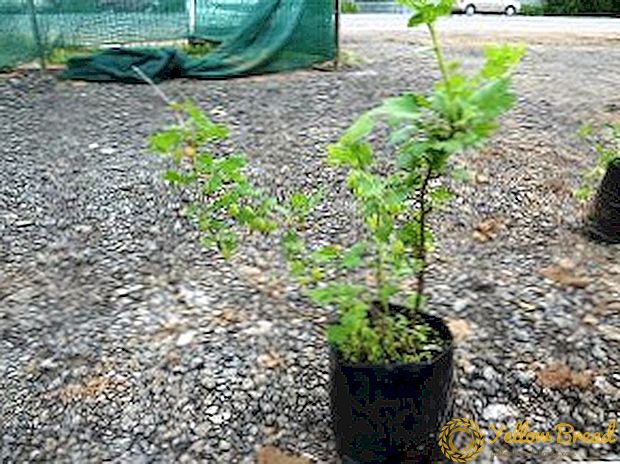 For planting using seedlings that already have from 3 to 5 roots of 10 cm length and 4-5 buds on each shoot. In the presence of dry roots and shoots they are pruned and, as a rule, they are added in drops (it is possible that they will also grow). 24-36 hours before planting, the roots of the seedling are immersed for the purpose of disinfection in a light (pale pink) solution of potassium permanganate or, if possible, are treated with a root growth stimulator.
For planting using seedlings that already have from 3 to 5 roots of 10 cm length and 4-5 buds on each shoot. In the presence of dry roots and shoots they are pruned and, as a rule, they are added in drops (it is possible that they will also grow). 24-36 hours before planting, the roots of the seedling are immersed for the purpose of disinfection in a light (pale pink) solution of potassium permanganate or, if possible, are treated with a root growth stimulator.
Proper planting of young gooseberry seedlings
It is not allowed to plant the Komandor gooseberry seedlings at an angle - just straight. The bush's neck deepens under the soil layer (5-6 cm), and the surface shoots are covered with earth. A compulsory first step after planting is soil compaction and watering (5-7 liters per bush), which is carried out through an annular groove 0.3-0.4 m from the planted plant. It is also desirable to make mulching pristvolnoy surface (humus or peat).
Care and cultivation of gooseberry "Commander"
As with most garden crops, a significant place in the process of caring for the Commander gooseberries, as it is grown, is watering, feeding, taking care of the soil, forming a bush, protecting from the weather. Features care for this variety will not lead to any serious additional hassle.
Watering and loosening the soil
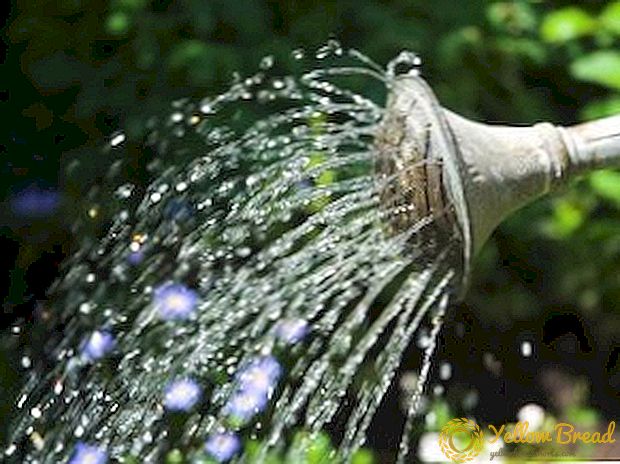 Gardeners cultivating the Komandor variety over the years indicate that watering of this gooseberry should be frequent, especially during the dry summer months. The intensity of water supply increases even more two weeks before the harvest, when the bushes "Commander" must be watered every other day.An essential element of care is regular loosening of the soil, taking care not to touch the roots. Loosening should be combined with weeding.
Gardeners cultivating the Komandor variety over the years indicate that watering of this gooseberry should be frequent, especially during the dry summer months. The intensity of water supply increases even more two weeks before the harvest, when the bushes "Commander" must be watered every other day.An essential element of care is regular loosening of the soil, taking care not to touch the roots. Loosening should be combined with weeding.
When and how to conduct dressing
In the early years, the need of the Commodore gooseberry in additional nutrition is provided by regular scattering of small amounts (20 g / sq. M) of nitrogenous fertilizers around the bush trunk. Subsequently, it will be necessary to annually feed an already well-fruiting bush (along the crown perimeter) with potassium sulfate, ammonium sulfate (50 g each) and 100 g of superphosphate mixed with a compost bucket. With an aqueous solution of mullein (1: 5), gooseberries are fed 15-20 days after flowering (up to 10 liters per bush).
Trim highlights
To develop steadily, consistently gaining strength, gooseberry "Commander" needs almost annual pruning, as a means of updating. By the end of the first year, no more than five of the strongest branches should be left out of the grown branches. To the same number it is necessary to reduce new shoots after the completion of the second year. Further annually leave 3-5 shoots, growing approximately equal distances from each other.After five years of development, aged (and diseased) branches are necessarily removed every year, and 3-4 annual shoots remain at the roots.
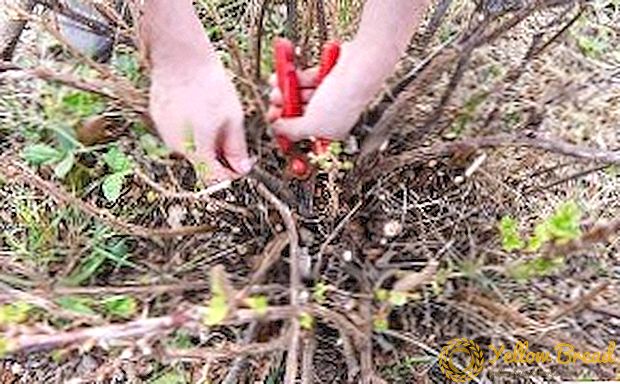
- early spring - before the start of sap flow and bud break;
- Late autumn - after the end of sap flow, which coincides with the end of leaf fall.
Shelter bushes for the winter
Gooseberry "Commander" is pronounced representative of frost-resistant varieties with a temperature threshold height of -25 ... -30 ° C. That is, it is necessary to do winter shelter for him either in an area where freezing temperatures are expected to be even lower, or for insurance against force majeure. In these cases, after the autumn pruning, peat or humus mulching of the soil is used in the near-stem circle with a 10-centimeter layer or cellophane bags filled with mulch with lots of holes toward the ground.For the shelter they use fallen snow, as much as possible completely filling the bushes, as well as pine or fir branches, and other available materials.
Time of ripening and harvesting
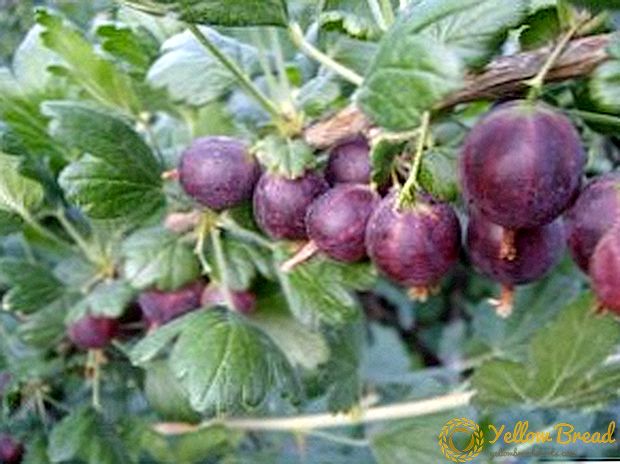 Gooseberry "Commander", striving for a 7-kilogram line of yield, already in the first years it is capable of producing 3–5 kg of berries. Fruiting of this variety begins in the second half of May, and the beginning of mass harvesting falls on dry weather in early July. Begin, for the purpose of the best subsequent safety, for one and a half to two weeks to full technical ripeness. Unripe berries (dry and intact) do not reach more than 10 days in a cool place.
Gooseberry "Commander", striving for a 7-kilogram line of yield, already in the first years it is capable of producing 3–5 kg of berries. Fruiting of this variety begins in the second half of May, and the beginning of mass harvesting falls on dry weather in early July. Begin, for the purpose of the best subsequent safety, for one and a half to two weeks to full technical ripeness. Unripe berries (dry and intact) do not reach more than 10 days in a cool place.
As the Commander berries ripen, they lose a whole range of colors, when their color consistently changes from green-red to red-brown, gradually turning into black.
The juicy, almost seedless flesh of perfectly smooth berries of the gooseberry "Komandor" has an excellent dessert taste, which attracts lovers of fresh sweetness (especially children) and canned juices and desserts.

